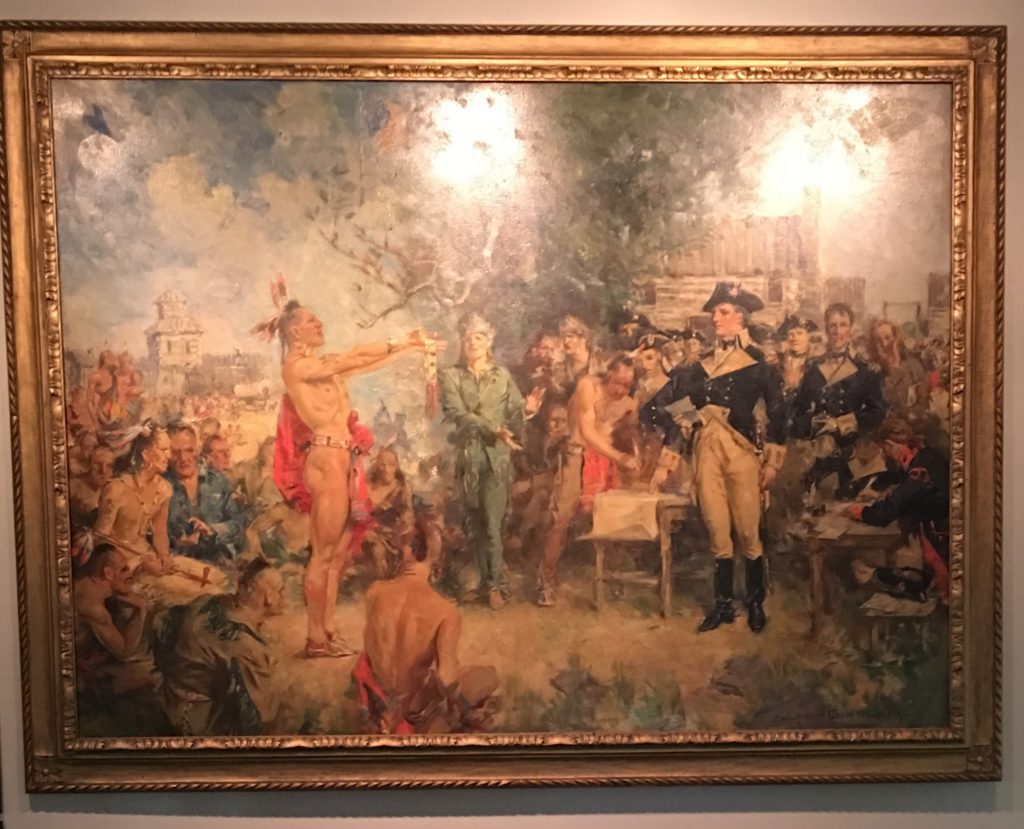 Following the Revolutionary War, American settlers left the east coast in search of land and opportunity. As they began to journey West, the pioneers began to encroach on the lands of the Indian tribes. These American Indians had lived here long before the English had arrived, crossing from Asia in the north. They had migrated throughout North America and as far as Central and South America. While many in the southern hemisphere established civilizations throughout, the Indians in the Northwest Territory were nomadic, moving from one location to the next in search of food and shelter. An estimated number of 15,000 had lived in Ohio at the time of the American Revolution.
Following the Revolutionary War, American settlers left the east coast in search of land and opportunity. As they began to journey West, the pioneers began to encroach on the lands of the Indian tribes. These American Indians had lived here long before the English had arrived, crossing from Asia in the north. They had migrated throughout North America and as far as Central and South America. While many in the southern hemisphere established civilizations throughout, the Indians in the Northwest Territory were nomadic, moving from one location to the next in search of food and shelter. An estimated number of 15,000 had lived in Ohio at the time of the American Revolution.
As the Europeans left the east coast in search of land in the Ohio Valley, the tribesman began to stand their ground to defend their lands, resulting in the American Indian Wars. By 1790, President George Washington sent General Josiah Harmar to fight against the Indians but was unable to defeat them. A second attempt, under the leadership of Anthony Wayne, the Indians were defeated at the Battle of Fallen Timbers on August 20. 1794. Within the next year, the Indians were invited to participate in a peace conference at Fort Green Ville. Shortly thereafter, the Treaty of Green Ville was signed on August 3, 1795, documenting land boundaries and providing compensation for the land in hopes of a peaceful compromise.
A beautiful painting by Howard Chandler Christy details the moment the Treaty of Green Ville was signed. Christy, a talented painter and Ohio native, had a passion for Ohio history. Mr. Christy was selected to paint the Signing of the Treaty of Green Ville in which he completed in July of 1945. This painting is on display at The Garst Museum in Greenville, Ohio.
The attendees are identified as the following, starting from the bottom left to right: Leatherlips, the Green Ville Treaty Calumet and Bad Bird. Above these Indians starting from left to right: White Pigeon, Tarhe: The Crane and Blue Jacket. The tall standing Indian is Little Turtle, then Buckongehelas. To the right of Little Turtle is William Wells, and continuing right are Isaac Zane, Meriwether Lewis and John Mills. The Indian signing The Treaty of Greene Ville is The Sun. The standing colonist is Anthony Wayne followed by William Clark, William Henry Harrison, David Jones and Henry De Butts.
Have you had the opportunity to visit The Garst Museum and see the Signing of the Treaty of Green Ville? I would love to hear about your visit if you would kindly leave a message in the comments section below. Many thanks for reading about the Treaty of Green Ville and wishing you many Happy Travels.
What to See and What to Do:
Garst Museum
205 North Broadway
Greenville, OH 45331
Telephone: 937 548 5250
- Admission: $12 for adults, $11 for seniors, $9 for youth, $9 for Darke County Genealogy Society Members, Free for children aged 5 and below and for DCHS Members
- Hours: Tuesday – Saturday from 10AM to 4PM & Sunday from 1PM to 4PM, Closed Mondays, Major Holidays and the Month of January
- Amenities: Historical exhibits, educational exhibits, research center, historic figures, museum store and special events
- Tips: Allow yourself plenty of time to visit each of the exhibits and wear comfortable shoes.
Where to Stay:
The Inn at Versailles
21 West Main Street
Versailles, OH 45380
Telephone: 937 526 3020
Where to Eat:
The Merchant House
406 South Broadway
Greenville, OH 45331
Telephone: 937 459 4405
Pig candy and the Monte Cristo sandwich….absolutely amazing!
Where to Drink:
Kennedy Vineyard
3911 State Route 722
New Madison, OH 45346
Telephone: 937 273 8381
What to Read:
- The Treaty of Green Ville, by Frazer Els Wilson
- Indians Timeless Tales, by Paul Wonning
- Life and Legacy of Annie Oakley, by Glenda Riley